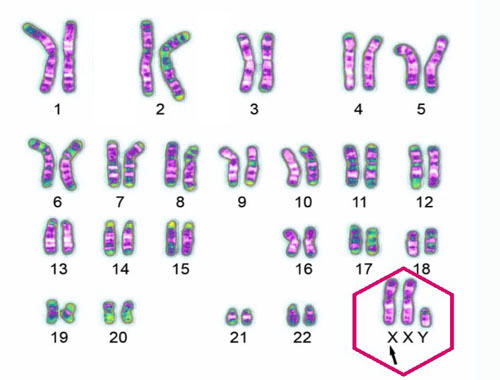Klinefelter Syndrome

Published: 18 Jun 2025
ICD9: 758.7 ICD10: Q98.0 ICD11: LD50.3
Klinefelter Syndrome is a genetic condition that affects males.
It occurs when a male is born with an extra X chromosome, resulting in a genotype of XXY instead of the typical XY.
Here's a breakdown of key aspects:
![]() Genetics: Normally, males have one X and one Y chromosome (XY), while females have two X chromosomes (XX). In Klinefelter Syndrome, there's an extra X chromosome (XXY, or sometimes variations like XXXY, XXYY). This extra chromosome disrupts male sexual development.
Genetics: Normally, males have one X and one Y chromosome (XY), while females have two X chromosomes (XX). In Klinefelter Syndrome, there's an extra X chromosome (XXY, or sometimes variations like XXXY, XXYY). This extra chromosome disrupts male sexual development.
![]() Symptoms and Characteristics: The symptoms can vary widely, and some individuals may not be diagnosed until adulthood. Common characteristics include:
Symptoms and Characteristics: The symptoms can vary widely, and some individuals may not be diagnosed until adulthood. Common characteristics include:![]()

![]() Small, firm testicles: This is due to impaired testicular development.
Small, firm testicles: This is due to impaired testicular development.![]()

![]() Reduced testosterone production: Leading to various effects.
Reduced testosterone production: Leading to various effects.![]()

![]() Infertility: Often the most significant issue. Sperm production is usually severely reduced or absent.
Infertility: Often the most significant issue. Sperm production is usually severely reduced or absent.![]()

![]() Gynecomastia: Enlarged breast tissue.
Gynecomastia: Enlarged breast tissue.![]()

![]() Tall stature with longer legs and shorter trunk: They may appear disproportionately tall.
Tall stature with longer legs and shorter trunk: They may appear disproportionately tall.![]()

![]() Less facial and body hair: Due to lower testosterone.
Less facial and body hair: Due to lower testosterone.![]()

![]() Learning disabilities and language difficulties: These are more common in Klinefelter Syndrome.
Learning disabilities and language difficulties: These are more common in Klinefelter Syndrome.![]()

![]() Shyness and social challenges: Some individuals may experience social difficulties.
Shyness and social challenges: Some individuals may experience social difficulties.![]()

![]() Weaker muscles: Muscle mass may be reduced.
Weaker muscles: Muscle mass may be reduced.![]()

![]() Increased risk of certain health problems: Such as osteoporosis, heart disease, diabetes, and autoimmune disorders.
Increased risk of certain health problems: Such as osteoporosis, heart disease, diabetes, and autoimmune disorders.
![]() Diagnosis:
Diagnosis:![]()

![]() Prenatal testing: Can sometimes be detected through amniocentesis or chorionic villus sampling.
Prenatal testing: Can sometimes be detected through amniocentesis or chorionic villus sampling.![]()

![]() Karyotype: A blood test that analyzes chromosomes is the definitive way to diagnose Klinefelter Syndrome.
Karyotype: A blood test that analyzes chromosomes is the definitive way to diagnose Klinefelter Syndrome.![]()

![]() Hormone testing: Low testosterone levels can suggest the condition, leading to further testing.
Hormone testing: Low testosterone levels can suggest the condition, leading to further testing.![]()

![]() Physical examination: Can raise suspicion, particularly when observing developmental delays or physical characteristics.
Physical examination: Can raise suspicion, particularly when observing developmental delays or physical characteristics.
![]() Treatment:
Treatment:![]()

![]() Testosterone replacement therapy (TRT): This is the primary treatment. It can help improve muscle strength, bone density, energy levels, facial and body hair, mood, and sexual function. It does *not* restore fertility.
Testosterone replacement therapy (TRT): This is the primary treatment. It can help improve muscle strength, bone density, energy levels, facial and body hair, mood, and sexual function. It does *not* restore fertility.![]()

![]() Speech and language therapy: To address learning difficulties.
Speech and language therapy: To address learning difficulties.![]()

![]() Physical therapy: To improve muscle strength and coordination.
Physical therapy: To improve muscle strength and coordination.![]()

![]() Occupational therapy: To help with daily living skills.
Occupational therapy: To help with daily living skills.![]()

![]() Psychological counseling: To address emotional and social challenges.
Psychological counseling: To address emotional and social challenges.![]()

![]() Breast reduction surgery: May be considered for severe gynecomastia.
Breast reduction surgery: May be considered for severe gynecomastia.![]()

![]() Assisted reproductive technologies (ART): In rare cases, sperm can be extracted directly from the testicles and used for in vitro fertilization (IVF) to achieve pregnancy. This is not a guaranteed solution.
Assisted reproductive technologies (ART): In rare cases, sperm can be extracted directly from the testicles and used for in vitro fertilization (IVF) to achieve pregnancy. This is not a guaranteed solution.
![]() Incidence: It's estimated to affect about 1 in 500 to 1 in 1,000 newborn males. Many men with Klinefelter Syndrome are never diagnosed.
Incidence: It's estimated to affect about 1 in 500 to 1 in 1,000 newborn males. Many men with Klinefelter Syndrome are never diagnosed.
![]() Important Considerations:
Important Considerations:![]()

![]() Early diagnosis and treatment are important to manage symptoms and improve quality of life.
Early diagnosis and treatment are important to manage symptoms and improve quality of life.![]()

![]() Individuals with Klinefelter Syndrome can live full and productive lives with appropriate medical care and support.
Individuals with Klinefelter Syndrome can live full and productive lives with appropriate medical care and support.![]()

![]() The severity of symptoms varies greatly.
The severity of symptoms varies greatly.![]()

![]() While infertility is common, it is not inevitable that every individual with Klinefelter Syndrome will be infertile, though it is highly likely.
While infertility is common, it is not inevitable that every individual with Klinefelter Syndrome will be infertile, though it is highly likely.
In summary, Klinefelter Syndrome is a genetic disorder affecting males, caused by an extra X chromosome. It leads to a range of physical and developmental issues, including reduced testosterone, infertility, and other health challenges. Treatment primarily involves testosterone replacement therapy and supportive therapies to manage symptoms and improve quality of life.